Wave Optics | Physics - Interference | 12th Physics : UNIT 7 : Wave Optics
Chapter: 12th Physics : UNIT 7 : Wave Optics
Interference
INTERFERENCE
The phenomenon of addition or superposition of two light waves
which produces increase in intensity at some points and decrease in intensity
at some other points is called interference
of light.
Superposition of waves refers to
addition of waves. The concept of superposition of mechanical waves is studied
in (XI Physics 11.7). When two waves simultaneously pass through a particle in
a medium, the resultant displacement of that particle is the vector addition of
the displacements due to the individual waves. The resultant displacement will
be maximum or minimum depending upon the phase difference between the two superimposing
waves. These concepts hold good for light as well.
Let us consider two light waves from
the two sources S1 and S2 meeting at a point P as shown in Figure 6.52.
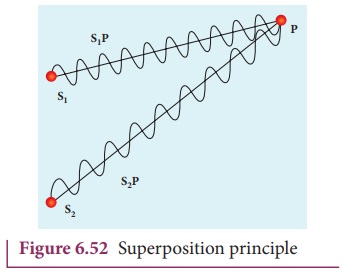
The wave from S1 at an instant t
at P is,
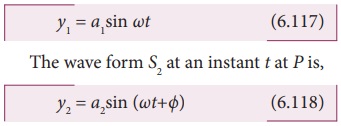
The two waves have different
amplitudes a1 and a2,
same angular frequency Žē, and a phase difference of ŽĢ between them. The resultant displacement will be given by,

The simplification of the above
equation by using trigonometric identities as done in (XI Physics 11.7) gives
the equation,
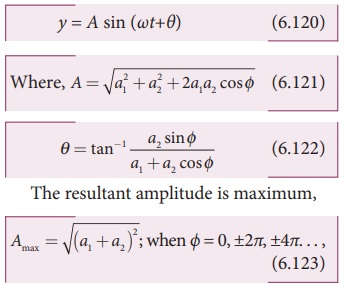
The resultant amplitude is minimum,

The intensity of light is
proportional to square of amplitude,
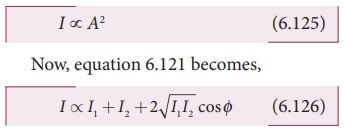
In equation 6.126 if the phase
difference, ŽĢ = 0, ┬▒2ŽĆ, ┬▒4ŽĆ. . . , it corresponds to the condition for maximum intensity of
light called as constructive interference.
The resultant maximum intensity is,

In equation 6.126 if the phase
difference, ŽĢ = ┬▒ŽĆ, ┬▒3ŽĆ, ┬▒5ŽĆ. . . , it corresponds to the condition for minimum intensity of
light called destructive
interference.
The resultant minimum intensity is,

As a special case, if a1 = a2 = a, then equation
6.121. becomes,
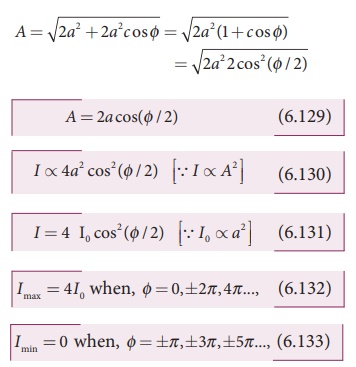
We conclude that the phase
difference ŽĢ, between the two
waves decides the intensity of light at that point where the two waves meet.
EXAMPLE 6.24
Two light sources with amplitudes 5
units and 3 units respectively interfere with each other. Calculate the ratio
of maximum and minimum intensities.
Solution
Amplitudes, a1 = 5, a2
= 3
Resultant amplitude,
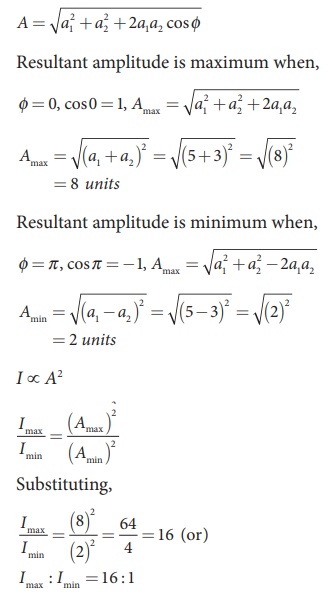
EXAMPLE 6.25
Two light sources of equal
amplitudes interfere with each other. Calculate the ratio of maximum and
minimum intensities.
Solution
Let the amplitude be a.
The intensity is, I ŌłØ ┬Ą 4a2 cos2(ŽĢ/ 2)
or I = 4I0 cos2(ŽĢ/2)
Resultant intensity is maximum when,
ŽĢ = 0, cos0 = 1, Imax
ŌłØ 4a2
Resultant amplitude is minimum when,
ŽĢ = ŽĆ, cos(ŽĆ/2) = 0, Imin = 0
Imax : Imin = 4a2 : 0
EXAMPLE 6.26
Two light sources have intensity of
light as I0. What is the
resultant intensity at a point where the two light waves have a phase
difference of ŽĆ/3?
Solution
Let the intensities be I0.
The
resultant intensity is, I = 4I0cos2(ŽĢ/2)
Resultant intensity
when, ŽĢ = ŽĆ / 3, is
I = 4I0 cos2
(ŽĆ/6)
I = 4Io (ŌłÜ3/2)2 = 3Io
1. Phase difference and path difference
Phase is the angular position of a
vibration. As a wave is progressing, there is a relation between the phase of
the vibration and the path travelled by the wave. One can express the phase in
terms of path and vice versa. In the path of the wave, one wavelength ╬╗ corresponds to a phase of 2ŽĆ as shown in Figure 6.53. A path
difference ╬┤ corresponds to a
phase difference ŽĢ as given by the equation,
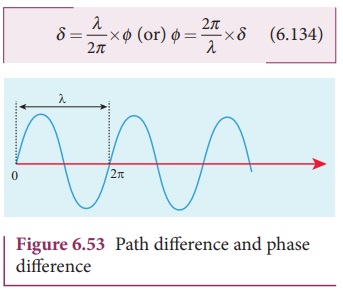
For constructive interference, the
phase difference should be, ŽĢ = 0, 2ŽĆ, 4ŽĆ . . . Hence, the path difference must be, ╬┤ = 0, ╬╗, 2╬╗ . . . In general, the integral multiples of ╬╗.

For destructive interference, phase
difference should be, ŽĢ = ŽĆ, 3ŽĆ, 5ŽĆ . . . Hence, the path
difference must be, ╬┤ = ╬╗/2 , 3╬╗/2 .....
In general, the half integral
multiples of ╬╗.

EXAMPLE 6.27
The wavelength of a light is 450 nm.
How much phase it will differ for a path of 3 mm?
Solution
The wavelength is, ╬╗ = 450 nm = 450├Ś10-9m
Path difference is, ╬┤ = 3 mm
= 3├Ś10ŌłÆ3m
Relation between phase difference
and path difference is, ŽĢ = 2ŽĆ/╬╗ ├Ś╬┤
Substituting,
ŽĢ = [ 2ŽĆ / 450├Ś10-9 ] ├Ś3├Ś10ŌłÆ3 = (ŽĆ/75) ├Ś106
ŽĢ = (ŽĆ/75) ├Ś106 rad
2. Coherent sources
Two light sources are said to be coherent if they produce waves
which have same phase or constant phase difference, same frequency or
wavelength (monochromatic), same waveform and preferably same amplitude. Coherence is a property of waves that enables to obtain
stationary interference patterns.
Two independent monochromatic
sources can never be coherent, because they may emit waves of same frequency
and same amplitude, but not with same phase. This is because, atoms while
emitting light, produce change in phase due to thermal vibrations. Hence, these
sources are said to be incoherent sources.
To obtain coherent light waves, we
have three techniques. They are,
(i) Intensity or
amplitude division
(ii) wavefront
division
(iii) source and images.
(i) Intensity or amplitude division: If we allow light to pass through a partially silvered mirror
(beam splitter), both reflection and refraction take place simultaneously. As
the two light beams are obtained from the same light source, the two divided
light beams will be coherent beams. They will be either in-phase or at constant
phase difference as shown in Figure 6.54. Instruments like MichelsonŌĆÖs
interferometer, Fabray-Perrot etalon work on this principle.
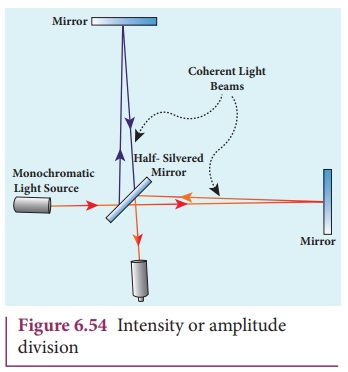
(ii) Wavefront division: This is the most
commonly used method for producing two coherent sources. We know a point source
produces spherical wavefronts. All the points on the wavefront are at the same
phase. If two points are chosen on the wavefront by using a double slit, the
two points will act as coherent sources as shown in Figure 6.55.
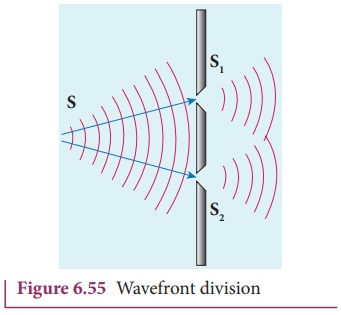
(iii) Source and images: In this method a source
and its image will act as a set of coherent source, because the source and its
image will have waves in-phase or constant phase difference as shown in Figure
6.56. The Instrument, FresnelŌĆÖs biprism uses two virtual sources as two
coherent sources and the instrument, LloydŌĆÖs mirror uses a source and its
virtual image as two coherent sources.
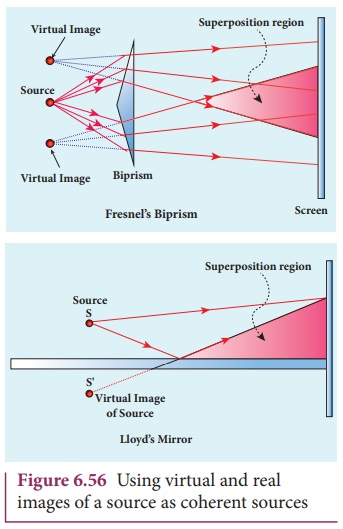
3. Double slit as coherent sources
Double slit uses the principle of
wavefront division. Two slits S1
and S2 illuminated by a
single monochromatic source S act as
a set of coherent sources. The waves from these two coherent sources travel in
the same medium and superpose. The constructive and destructive interference
are shown in Figure 6.57(a).The crests of the waves are shown by thick
continuous lines and troughs are shown by broken lines in Figure 6.57(b).
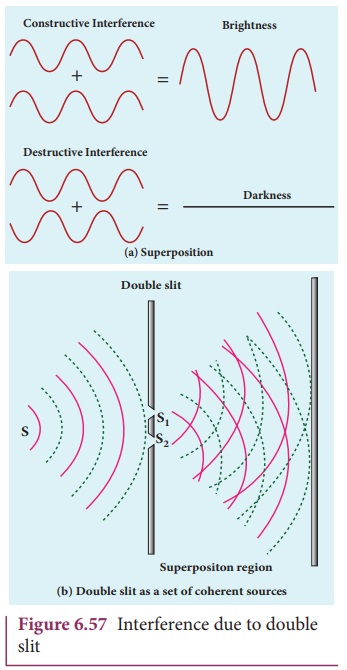
At points where the crest of one
wave meets the crest of the other wave or the trough of one wave meets the
trough of the other wave, the waves are in-phase. Hence, the displacement is
maximum and these points appear bright. This type of interference is said to be
constructive
interference.
At points where the crest of one
wave meets the trough of the other wave and vice versa, the waves are
out-of-phase. Hence, the displacement is minimum and these points appear dark.
This type of interference is said to be destructive interference.
On a screen the intensity of light
will be alternatively maximum and minimum i.e. bright and dark bands which are
referred as interference fringes.
4. YoungŌĆÖs double slit experiment
Thomas Young, a British Physicist
used an opaque screen with two small openings called double slit S1 and S2 kept equidistance from a source S as shown in Figure 6.62. The width of each slit is about 0.03 mm
and they are separated by a distance of about 0.3 mm. As S1 and S2
are equidistant from S, the light
waves from S reach S1 and S2 in-phase. So, S1
and S2 act as coherent sources
which are the requirement of obtaining interference pattern.
Experimental setup
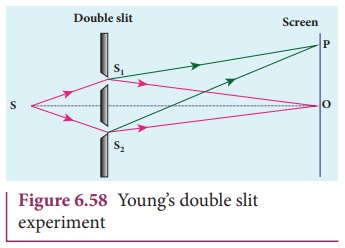
Wavefronts from S1 and S2
spread out and overlapping takes place to the right side of double slit. When a
screen is placed at a distance of about 1 meter from the slits, alternate
bright and dark fringes which are equally spaced appear on the screen. These
are called interference fringes or bands. Using an eyepiece the fringes can be
seen directly. At the center point O on
the screen, waves from S1
and S2 travel equal
distances and arrive in-phase as shown in Figure 6.58. These two waves
constructively interfere and bright fringe is observed at O. This is called central bright fringe. The fringes disappear and
there is uniform illumination on the screen when one of the slits is covered.
This shows clearly that the bands are due to interference.
Equation for path difference
The schematic diagram of the
experimental set up is shown in Figure 6.59.
The Let d be the distance between the double slits S1 and S2
which act as coherent sources of wavelength ╬╗.
A screen is placed parallel to the double slit at a distance D from it. The mid-point of S1 and S2 is C and
the mid-point of the screen O is
equidistant from S1 and S2. P is any point at a distance y
from O. The waves from S1 and S2 meet at P either
in-phase or out-of-phase depending upon the path difference between the two waves.
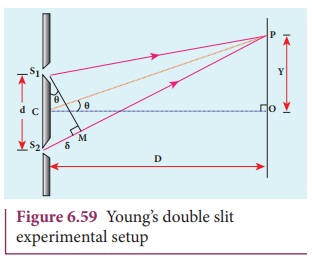
The path difference ╬┤ between the light waves from S1 and S2 to the point P is,
╬┤ = S2P ŌĆō S1P
A perpendicular is dropped from the point
S1 to the line S2P at M to find the path
difference more precisely.
╬┤ = S2P ŌĆō MP
= S2M ŌĆ”ŌĆ”.(6.137)

The angular position of the point P from C is ╬Ė. ŌłĀOCP = ╬Ė.
From the geometry, the angles ŌłĀOCP and ŌłĀS2S1M are equal.
ŌłĀOCP = ŌłĀS2S1M = ╬Ė.
In right angle triangle ŌłåS1S2M, the path
difference, S2M = d
sin ╬Ė

If the angle ╬Ė is small, sin ╬Ė Ōēł tan ╬Ė Ōēł ╬Ė
From the right angle triangle ŌłåOCP, tan╬Ė = y/D

Based on the condition on the path
difference, the point P may have a
bright or dark fringe.
Condition for bright fringe (or) maxima
The condition for the constructive
interference or the point P to be
have a bright fringe is,
Path difference, ╬┤ = n╬╗
where, n = 0, 1, 2, . . .
Ōł┤ d y/D = n╬╗
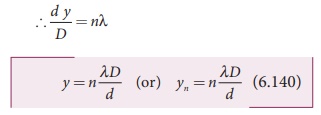
This is the condition for the point P to be a bright fringe. The distance is
the distance of the nth bright fringe
from the point O.
Condition for dark fringe (or) minima
The condition for the destructive
interference or the point P to be
have a dark fringe is,
Path difference, ╬┤ = (2n ŌłÆ1) ╬╗/2
where, n = 1, 2, 3 . . .
Ōł┤ d
y/D = (2n ŌłÆ1) ╬╗/2

This is the condition for the point
P to be a dark fringe. The distance yn
is the distance of the nth
dark fringe from the point O.
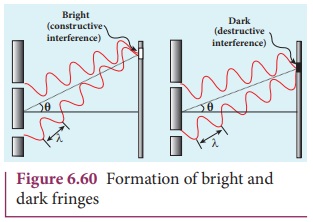
The formation of bright and dark
fringes is shown in Figure 6.60.
This shows that on the screen,
alternate bright and dark bands are seen on either side of the central bright
fringe. The central bright is referred as 0th bright followed by 1st
dark and 1st bright and then 2nd dark and 2nd bright and so on, on either side
of O successively as shown in Figure
6.61.
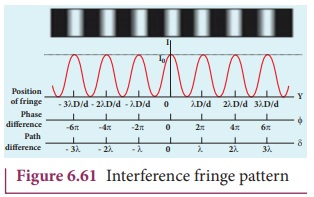
Equation for bandwidth
The bandwidth (╬▓) is
defined as the distance between any two consecutive bright or dark fringes.
The distance between (n+1)th and nth consecutive bright fringes from O is given by,
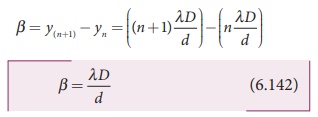
Similarly, the distance between (n+1)th and n consecutive dark fringes from O is given by,
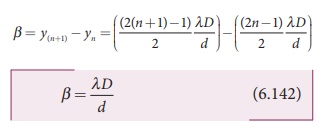
Equations (6.142) show that the
bright and dark fringes are of same width equally spaced on either side of
central bright fringe.
Conditions for obtaining clear and broad interference bands
(i) The
screen should be as far away from the source as possible.
(ii) The wavelength
of light used must be larger.
(iii) The two
coherent sources (here S1
and S2) must be as close
as possible.
EXAMPLE 6.28
In YoungŌĆÖs double slit experiment,
the two slits are 0.15 mm apart. The light source has a wavelength of 450 nm.
The screen is 2 m away from the slits.
(i) Find the distance of the second
bright fringe and also third dark fringe from the central maximum.
(ii) Find the fringe width.
(iii) How will the fringe pattern
change if the screen is moved away from the slits?
(iv) What will happen to the fringe
width if the whole setup is immersed in water of refractive index 4/3.
Solution
d = 0.15 mm = 0.15├Ś 10-3 m;
D = 2 m;
╬╗ = 450 nm = 450 ├Ś 10-9 m; n = 4/3
(i) Equation for nth bright fringe is,
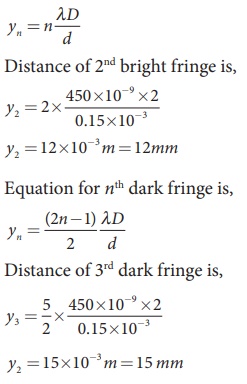
(ii) Equation for fringe width is,
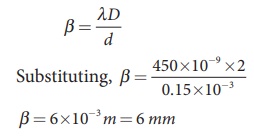
(iii) The fringe width will increase
as D is increased,

(iv) The fringe width will decrease
as the setup is immersed in water of refractive index 4/3

The wavelength will decrease
refractive index n times.
Hence, ╬▓ ŌłØ ╬╗ and ╬▓ŌĆÖ ŌłØ ╬╗ŌĆÖ
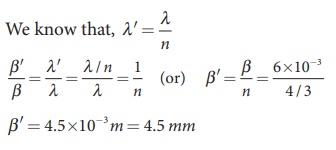
5. Interference with polychromatic light
When a polychromatic light (white
light) is used in interference experiment, coloured fringes of varied thickness
will be formed on the screen. This is because, different colours have different
wavelengths. However, the central fringe or 0th fringe will always
be bright and white in colour, because for all the colours falling at the point
O will have no path difference.
Hence, only constructive interference is possible at O for all the colours.
EXAMPLE 6.29
Two lights of wavelengths 560 nm and
420 nm are used in YoungŌĆÖs double slit experiment. Find the least distance from
the central fringe where the bright fringe of the two wavelengths coincides.
Given D = 1 m and d = 3 mm.
Solution
╬╗ = 560 nm = 560├Ś10ŌłÆ9 m;
╬╗2 = 420 nm = 420├Ś10ŌłÆ9
m;
D = 1 m;d = 3 mm = 3├Ś10ŌłÆ3 m
For a given y, n and ╬╗ are inversely proportional.
Let nth order bright fringe of ╬╗1
coincides with (n+1)th
order bright fringe of ╬╗2.
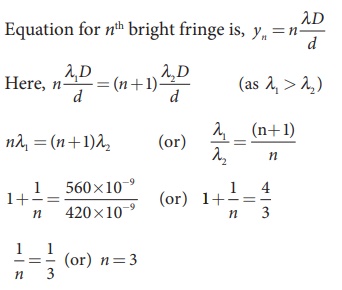
Thus, the 3rd bright fringe of ╬╗1 and 4th bright fringe of ╬╗2 coincide at the least
distance y.
The least distance from the central
fringe where the bright fringes of the two wavelengths coincides is, yn = n [(╬╗D)/d]
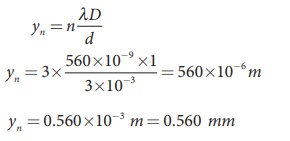
Dazzling colours are exhibited by
thin films of oil spread on the surface of water and also by soap bubbles as
shown in the figure. These colours are due to interference of white light
undergoing multiple reflections from the top and the bottom surfaces of thin
films. The colour depends upon the thickness of the film, refractive index of
the film and also the angle of incidence of the light.
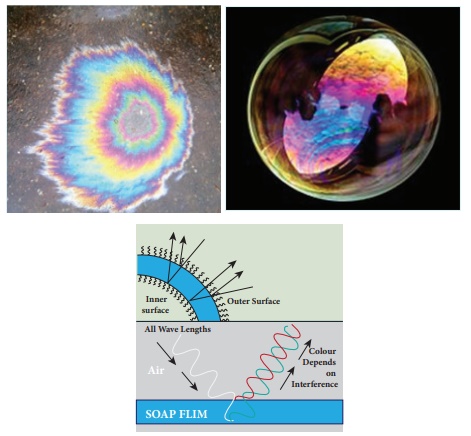
6. Interference in thin films
Let us consider a thin film of
transparent material of refractive index ┬Ą
(not to confuse with order of fringe n)
and thickness d. A parallel beam of
light is incident on the film at an angle i
as shown in Figure 6.62. The wave is divided into two parts at the upper
surface, one is reflected and the other is refracted. The refracted part, which
enters into the film, again gets divided at the lower surface into two parts;
one is transmitted out of the film and the other is reflected back in to the
film. Reflected as well as refracted waves are sent by the film as multiple
reflections take place inside the film. The interference is produced by both
the reflected and transmitted light.
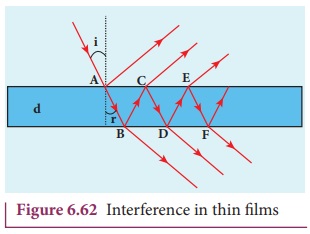
For transmitted light
The light transmitted may interfere
to produce a resultant intensity. Let us consider the path difference between
the two light waves transmitted from B and
D. The two waves moved together and remained in phase up to B where splitting occurred. The extra
path travelled by the wave transmitted from D
is the path inside the film, BC +
CD. If we approximate the incidence
to be nearly normal (i = 0), then the
points B and D are very close to each other. The extra distance travelled by the
wave is approximately twice thickness of the film, BC + CD = 2d. As this extra path is traversed in a
medium of refractive index ┬Ą, the
optical path difference is, ╬┤ = 2┬Ąd.
The condition for constructive interference
in transmitted ray is,

Similarly, the condition for
destructive interference in transmitted ray is,

For reflected light
It is experimentally and
theoretically proved that a wave while travelling in a rarer medium and getting
reflected by a denser medium, undergoes a phase change of ŽĆ. Hence, an additional path difference of ╬╗/2 should be considered.
Let us consider the path difference
between the light waves reflected by the upper surface at A and the other wave coming out at C after passing through the film. The additional path travelled by
wave coming out from C is the path
inside the film, AB + BC. For nearly
normal incidence this distance could be
approximated as, AB + BC = 2d. As this extra path is travelled in the medium of refractive
index ┬Ą, the optical path difference
is, ╬┤ = 2┬Ąd.
The condition for constructive
interference for reflected ray is,

The additional path difference ╬╗/2 is due to the phase change of ŽĆ in rarer to denser reflection taking
place at A.
The condition for destructive
interference for reflected ray is,

If the incidence is not nearly
normal, but at an angle of incidence i which
has an angle of refraction r, then
the expression for path difference 2┬Ąd on
the left hand side of the above equations are to be replaced with the
expression, 2┬Ąd cos r.
EXAMPLE 6.30
Find the minimum thickness of a film
of refractive index 1.25, which will strongly reflect the light of wavelength
589 nm. Also find the minimum thickness of the film to be anti-reflecting.
Solution
╬╗ = 589 nm = 589├Ś10ŌłÆ9 m
For the film to have strong reflection,
the reflected waves should interfere constructively. The least optical path
difference introduced by the film should be ╬╗/2.
The optical path difference between the waves reflected from the two surfaces
of the film is 2┬Ąd. Thus, for strong
reflection, 2┬Ąd = ╬╗/2 [As given in equation 6.145. with n = 1]
Rewriting, d = ╬╗/4╬╝
Substituting, d = [589├Ś109] / [4├Ś1.25] = 117.8├Ś10ŌłÆ9
d = 117.8├Ś10ŌłÆ9 = 117.8 nm
For the film to be anti-reflecting,
the reflected rays should interfere destructively. The least optical path
difference introduced by the film should be ╬╗.
The optical path difference between the waves reflected from the two surfaces
of the film is 2┬Ąd. For strong
reflection, 2┬Ąd = ╬╗ [As given in equation 6.146. with n = 1].
Rewriting, d = ╬╗/2╬╝
Substituting, d = [589├Ś109] / [2├Ś1.25] = 235.6├Ś10ŌłÆ9
d = 235.6├Ś10ŌłÆ9 = 235.6 nm
Related Topics